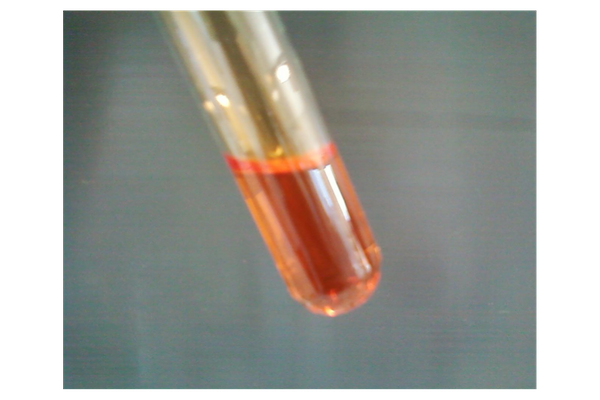5.6.2
Reactions 2
Testing for Alkenes
Testing for Alkenes
We can test a solution to see if the alkene function group is present.


The test
The test
- Add bromine water to the solution.
- If an alkene is present, the solution will lose its orange colour and become colourless.
- If an alkene is not present, it will NOT decolourise and the solution remains orange.


How the test works
How the test works
- The test works because:
- If the alkene is present, it can undergo an addition reaction with the bromine.
- This removes the bromine (in the bromine water) and forms a halogenoalkane - so the colour is lost.


Bromine water
Bromine water
- As a quick note, bromine water is just water with a small amount of bromine dissolved in it.
- Bromine water is what colours the solution orange until it has reacted with the alkene.
Testing for Carboxylic Acids
Testing for Carboxylic Acids
We can test to see if a carboxylic acid is present in a solution.
%208.3.3.1%20-%20acid%20test,h_400,q_80,w_640.png)
%208.3.3.1%20-%20acid%20test,h_400,q_80,w_640.png)
The test
The test
- Firstly we must react the carboxylic acid with sodium carbonates.
- The reaction with the carbonate ions should form a salt + CO2 + H2O
- We can then test for the CO2 produced using limewater.
%208.3.3.1%20-%20acid%20test,h_400,q_80,w_640.png)
%208.3.3.1%20-%20acid%20test,h_400,q_80,w_640.png)
Limewater
Limewater
- Limewater is a clear solution but it is turned cloudy if CO2 is present.
- This means we must pump the gas, produced from the reaction between the sample and the carbonate, into limewater.
- If limewater turns cloudy: carboxylic acid is present in the initial solution.
- If limewater stays clear: carboxylic acid is NOT present in the initial solution.
- This means we must pump the gas, produced from the reaction between the sample and the carbonate, into limewater.
1Physical Chemistry
1.1Atomic Structure
1.1.1Fundamental Particles
1.1.2Isotopes & Mass Number
1.1.3Mass Spectrometry
1.1.4Electron Shells, Sub-Shells & Orbitals
1.1.5Electron Configuration
1.1.6Ionisation Energy
1.1.7Factors Affecting Ionisation Energies
1.1.8Trends of Ionisation
1.1.9Specific Impacts on Ionisation Energies
1.1.10End of Topic Test - Atomic Structure
1.1.11A-A* (AO3/4) - Atomic Structure
1.2Amount of Substance
1.2.1Relative Masses
1.2.2The Mole
1.2.3The Ideal Gas Equation
1.2.4Empirical & Molecular Formulae
1.2.5Balanced Equations
1.2.6Percentage Yield
1.2.7A-A* (AO3/4) - Percentage Yield
1.2.8Atom Economy
1.2.9End of Topic Test - Amount of Substance
1.2.10A-A* (AO3/4) - Substances & Yield
1.2.11Diagnostic Misconceptions - Moles
1.3Bonding
1.3.1Ionic Bonding
1.3.2Covalent & Dative Bonding
1.3.3Carbon Structures
1.3.4Metallic Bonding
1.3.5Physical Properties
1.3.6Shapes of Molecules
1.3.7Polarity
1.3.8Intermolecular Forces
1.3.9Intermolecular Forces 2
1.3.10End of Topic Test - Bonding
1.3.11Exam-Style Question - Shape of Molecules
1.3.12A-A* (AO3/4) - Bonding
1.3.13Diagnostic Misconceptions - Ions
1.3.14Diagnostic Misconceptions - Ionic & Covalent
1.3.15Diagnostic Misconceptions - Phase Change
1.3.16Diagnostic Misconceptions - Boiling
1.3.17Diagnostic Misconceptions - Polar Bonds
1.4Energetics
1.5Kinetics
1.6Equilibria
2Physical Chemistry 2 (A2 Only)
2.1Thermodynamics (A2 Only)
2.2Rate Equations (A2 Only)
2.3The Equilibrium Constant Kp (A2 Only)
2.4Electrochemical Cells (A2 Only)
2.5Acids & Bases (A2 Only)
2.5.1Brønsted-Lowry Acids & Bases (A2 Only)
2.5.2pH (A2 Only)
2.5.3The Ionic Product of Water (A2 Only)
2.5.4Weak Acids & Bases (A2 Only)
2.5.5pH Curves & Titrations (A2 Only)
2.5.6pH Curves & Titrations 2 (A2 Only)
2.5.7Buffer Solutions (A2 Only)
2.5.8End of Topic Test - Acids & Bases
2.5.9Exam-Style Question - Weak Acids
2.5.10A-A* (AO3/4) - Acids & Bases
2.5.11Diagnostic Misconceptions - Ammonia is an Alkali
2.5.12Diagnostic Misconceptions - Water's Neutrality
2.5.13Diagnostic Misconceptions - Concentrate & Strength
3Inorganic Chemistry
3.1Periodicity & Trends
4Inorganic Chemistry 2 (A2 Only)
4.1Period 3 (A2 Only)
4.2Transition Metals (A2 Only)
4.2.1General Properties (A2 Only)
4.2.2Substitution Reactions (A2 Only)
4.2.3Shapes of Complex Ions (A2 Only)
4.2.4Colours of Ions (A2 Only)
4.2.5Variable Oxidation States (A2 Only)
4.2.6Titrations (A2 Only)
4.2.7Homogeneous Catalysts (A2 Only)
4.2.8Heterogeneous Catalysts (A2 Only)
4.2.9End of Topic Test - Transition Metals
4.2.10A-A* (AO3/4) - Transition Metals
4.3Reactions of Ions in Aqueous Solutions (A2 Only)
5Organic Chemistry 1
5.1Introduction
5.2Alkanes
5.3Halogenoalkanes
5.4Alkenes
5.5Alcohols
5.6Organic Analysis
5.7A-A* (AO3/4) - Organic 1
6Organic Chemistry 2 (A2 Only)
6.1Optical Isomerism (A2 Only)
6.2Aldehydes & Ketones (A2 Only)
6.3Carboxylic Acids & Esters (A2 Only)
6.4Aromatic Chemistry (A2 Only)
6.5Amines (A2 Only)
6.6Polymers (A2 Only)
6.7Biological Organic (A2 Only)
6.8Organic Synthesis (A2 Only)
6.9NMR Spectroscopy (A2 Only)
6.10Chromatography (A2 Only)
6.11A-A* (AO3/4) - Organic 2
Jump to other topics
1Physical Chemistry
1.1Atomic Structure
1.1.1Fundamental Particles
1.1.2Isotopes & Mass Number
1.1.3Mass Spectrometry
1.1.4Electron Shells, Sub-Shells & Orbitals
1.1.5Electron Configuration
1.1.6Ionisation Energy
1.1.7Factors Affecting Ionisation Energies
1.1.8Trends of Ionisation
1.1.9Specific Impacts on Ionisation Energies
1.1.10End of Topic Test - Atomic Structure
1.1.11A-A* (AO3/4) - Atomic Structure
1.2Amount of Substance
1.2.1Relative Masses
1.2.2The Mole
1.2.3The Ideal Gas Equation
1.2.4Empirical & Molecular Formulae
1.2.5Balanced Equations
1.2.6Percentage Yield
1.2.7A-A* (AO3/4) - Percentage Yield
1.2.8Atom Economy
1.2.9End of Topic Test - Amount of Substance
1.2.10A-A* (AO3/4) - Substances & Yield
1.2.11Diagnostic Misconceptions - Moles
1.3Bonding
1.3.1Ionic Bonding
1.3.2Covalent & Dative Bonding
1.3.3Carbon Structures
1.3.4Metallic Bonding
1.3.5Physical Properties
1.3.6Shapes of Molecules
1.3.7Polarity
1.3.8Intermolecular Forces
1.3.9Intermolecular Forces 2
1.3.10End of Topic Test - Bonding
1.3.11Exam-Style Question - Shape of Molecules
1.3.12A-A* (AO3/4) - Bonding
1.3.13Diagnostic Misconceptions - Ions
1.3.14Diagnostic Misconceptions - Ionic & Covalent
1.3.15Diagnostic Misconceptions - Phase Change
1.3.16Diagnostic Misconceptions - Boiling
1.3.17Diagnostic Misconceptions - Polar Bonds
1.4Energetics
1.5Kinetics
1.6Equilibria
2Physical Chemistry 2 (A2 Only)
2.1Thermodynamics (A2 Only)
2.2Rate Equations (A2 Only)
2.3The Equilibrium Constant Kp (A2 Only)
2.4Electrochemical Cells (A2 Only)
2.5Acids & Bases (A2 Only)
2.5.1Brønsted-Lowry Acids & Bases (A2 Only)
2.5.2pH (A2 Only)
2.5.3The Ionic Product of Water (A2 Only)
2.5.4Weak Acids & Bases (A2 Only)
2.5.5pH Curves & Titrations (A2 Only)
2.5.6pH Curves & Titrations 2 (A2 Only)
2.5.7Buffer Solutions (A2 Only)
2.5.8End of Topic Test - Acids & Bases
2.5.9Exam-Style Question - Weak Acids
2.5.10A-A* (AO3/4) - Acids & Bases
2.5.11Diagnostic Misconceptions - Ammonia is an Alkali
2.5.12Diagnostic Misconceptions - Water's Neutrality
2.5.13Diagnostic Misconceptions - Concentrate & Strength
3Inorganic Chemistry
3.1Periodicity & Trends
4Inorganic Chemistry 2 (A2 Only)
4.1Period 3 (A2 Only)
4.2Transition Metals (A2 Only)
4.2.1General Properties (A2 Only)
4.2.2Substitution Reactions (A2 Only)
4.2.3Shapes of Complex Ions (A2 Only)
4.2.4Colours of Ions (A2 Only)
4.2.5Variable Oxidation States (A2 Only)
4.2.6Titrations (A2 Only)
4.2.7Homogeneous Catalysts (A2 Only)
4.2.8Heterogeneous Catalysts (A2 Only)
4.2.9End of Topic Test - Transition Metals
4.2.10A-A* (AO3/4) - Transition Metals
4.3Reactions of Ions in Aqueous Solutions (A2 Only)
5Organic Chemistry 1
5.1Introduction
5.2Alkanes
5.3Halogenoalkanes
5.4Alkenes
5.5Alcohols
5.6Organic Analysis
5.7A-A* (AO3/4) - Organic 1
6Organic Chemistry 2 (A2 Only)
6.1Optical Isomerism (A2 Only)
6.2Aldehydes & Ketones (A2 Only)
6.3Carboxylic Acids & Esters (A2 Only)
6.4Aromatic Chemistry (A2 Only)
6.5Amines (A2 Only)
6.6Polymers (A2 Only)
6.7Biological Organic (A2 Only)
6.8Organic Synthesis (A2 Only)
6.9NMR Spectroscopy (A2 Only)
6.10Chromatography (A2 Only)
6.11A-A* (AO3/4) - Organic 2
Unlock your full potential with Seneca Premium
Unlimited access to 10,000+ open-ended exam questions
Mini-mock exams based on your study history
Unlock 800+ premium courses & e-books